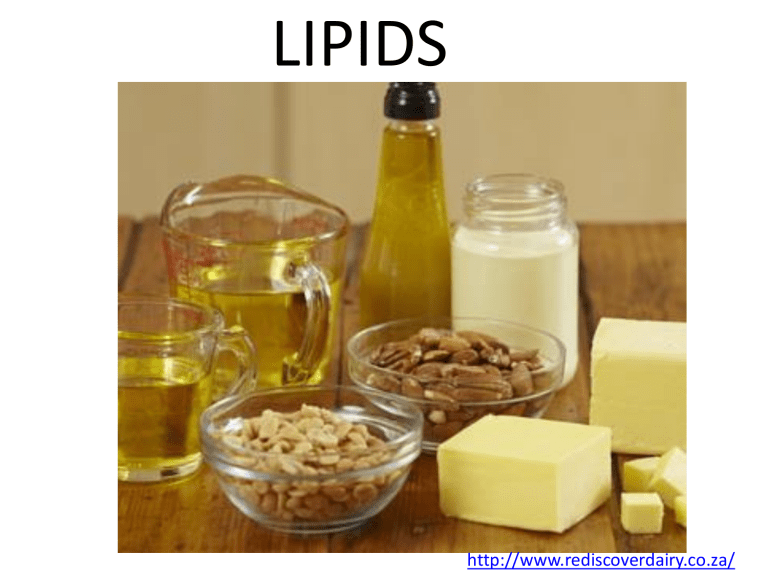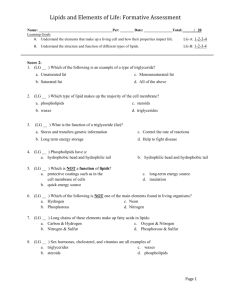
LIPIDS http://www.rediscoverdairy.co.za/ What are Lipids? • Lipids are loosely defined group of molecules with one main characteristic: they are insoluble in water • Their chemistry is highly varied • They all dissolve in organic solvent e.g. Ether, chloroform and benzene • Made up of carbon, hydrogen and oxygen but have lower proportion of oxygen than carbohydrates Functions • Lipids store energy -Contains more energy than carbohydrates • Lipids make membranes • Lipids serve as insulator • Some lipids serve as chemical messengers • Others communicate signals Classes of Lipids • Fats and oils • Phospholipids • Waxes • Steroids (like cholesterol) Fats and Oils • They are the commonest lipids in nature • Fats and oils are chemically extremely similar but at room temperature fats are solids (saturated) while oils are liquids (mostly unsaturated) • Animals store fat (energy and insulator) • Plants store oils rather than fats (seeds/nuts) • Building blocks- fatty acids and glycerol (an alcohol) Fatty acid structure http://biology.clc.uc.edu/courses/bio104/lipids.htm Fats & Oils (Saturated & Unsaturated) http://biology.clc.uc.edu/courses/bio104/lipids.htm 3 Condensation reactions (esterification) Lipid (Triglyceride) formation http://weloveteaching.com/ Triglyceride Ester link Grouping of fatty acids • Fatty acids with less than 6 carbons in their chains may collectively be called shortchain fatty acids, usually called carboxylic acids and are not “fatty” acids. • Those with 6 to 12 carbons are mediumchain fatty acids. • Those with 14 to 22 carbons are longchain fatty acids • Those with over 22 carbons are the verylong-chain fatty acids. Grouping of fats and oils • Those which contain primarily medium-chain fatty acids are called to medium-chain triglycerides (MCTs). • Those which contain primarily long-chain fatty acids are called long-chain triglycerides (LCTs). • Most of the fats and oils in our diets and the common names we know are LCTs. Examples of fatty acid and their source • Butyric acid (C4): Milk • Lauric acid (C12): Nutmeg; Palm kernel • Myristic acid (C14): Nutmeg; Palm kernel • Palmitic acid (C16): Olive oil; Animal lipids • Stearic acid (C18): Cocoa butter; Animal lipids Phospholipids • These are lipids containing a phosphate group e.g. Lecithin in eggs • Phospholipids are also made from glycerol, two fatty acids, and a phosphate group (in place of the third fatty acid) with some other molecule attached to its other end. Structure of Phospholipids Functions of Phospholipids • Vital component of cell membranes • Needed for the formation of neurotransmitter substances (for nervous system) Phospholipids molecule • The lipid part (hydrocarbon tails of the fatty acids) are hydrophobic (water-hating, hence insoluble in water), but the phosphate group end is hydrophilic (water loving, hence soluble in water). This means that phospholipids are soluble in both water and oil. Phospholipids Bilayer • Our cell membranes are made mostly of phospholipids arranged in a double layer. • The tails from both layers are “inside” (facing toward each other) and the heads are facing “out” (toward the watery environment) on both surfaces Lipid bilayer http://people.csail.mit.edu/seneff/lipid_bilayer.jpg Phospholipids bilayer illustration Water Hydrophobic tail (Fatty acid) Hydrophilic Head (Phosphoric acid) Oil Water Waxes • These are lipids made up of very long chain fatty acids joined to alcohols. • Difference between fats and waxes is the joining of only one fatty acid to each alcohol in waxes because the alcohol only have one hydroxyl group unlike glycerol with three in fats. • Waxes are very insoluble & are used by plants and animals for water proofing. • Some waxes produced by insects to protect their cuticle from water loss can withstand extreme high temperatures without melting. Steroids • Found in membranes • Also function as hormones • E.g. Cholesterol (found in most animal cell membrane), testosterone, estrogen • Composed of 4 fused carbon rings • Various other groups/molecules are attached around the edges Structure of steroid Cholesterol • Our bodies make about 2 g of cholesterol per day (85% of blood cholesterol). • Only about 15% comes from dietary sources. • Cholesterol is the precursor to our sex hormones and Vitamin D. • Vitamin D is formed by the action of UV light in sunlight on cholesterol molecules that have “risen” to near the surface of the skin. Vitamin D production & metabolism http://www.scientificpsychic.com/health/vitamins.html Vitamins and Minerals Vitamins • Vitamins are used to produce energy and synthesize tissues, enzymes, hormones, and other vital compounds. • Some are soluble in fat (Vit A, D, E and K) and some soluble in water (Vit B complex-B1,2,6,12 & C and many more) Quick Quiz 1. In a tabular form, list the various vitamins you know, their major functions and sources. • i.e. Vit/Functions/Sources 2. List some minerals required by living things. • Name & Matric number • 8 minutes Read up these at home (refresh yourself) Minerals • Sourced from inorganic salts or as part of carboncontaining organic compounds. • Magnesium is present in chlorophyll, the pigment that makes plants green. • NPK- component of inorganic fertilizer for plant. • Six minerals are required by people in gram amounts (macrominerals): Na, K, Ca, Mg, P and Cl. Daily requirements range from 0.3 to 2.0 grams per day. • Nine trace minerals (microminerals)- Cu, I, Fe, F, Mn, Zn , Cr (Chromium), Mo (Molybdenum), Se (Selenium). Functions of some minerals • Calcium is the most abundant mineral in the human body. More than 99% of total body calcium is stored in the bones and teeth. Calcium is also found in body fluids where its function is to regulate contractions of blood vessels and muscles. • Iodine is primarily involved in the synthesis of thyroid hormones. • Iron is a component of haemoglobin, myoglobin, and many enzymes in the body.






